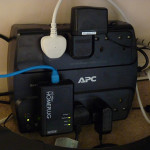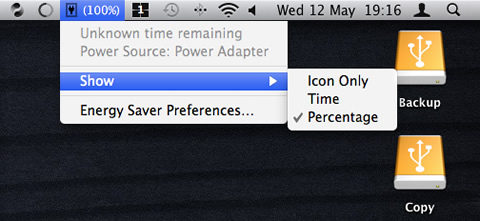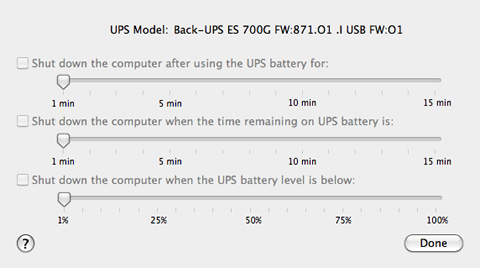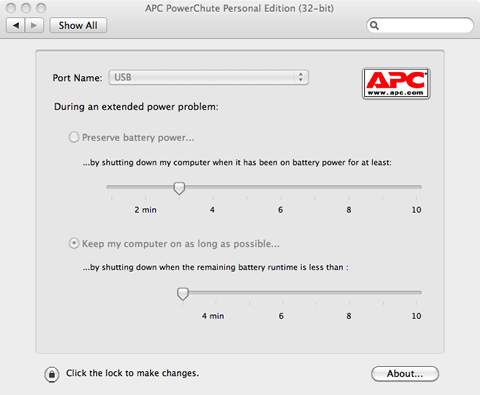APC BE700G UPS reviewed with 27″ iMac
I’m taking a look at the APC BE700G UPS, using it with a 27″ iMac simply because there’s no good information out there on how long Apple’s latest consumer desktop behemoth will last on UPS backup battery, how well the OSX works with such devices and how easy they are to set up. In short, choosing an iMac UPS isn’t straightforward.
Laptops are prevalent these days, we take them for granted and are often quite happy to give up any extra grunt that a desktop PC would offer in favour of increased mobility and a computer which does not invade the home. I recently took the plunge back to desktop computing, however, and one thing I realised about laptops, one of their greatest strengths, is that the battery protects them from accidental unplugging and power cuts.
When I was considering picking up the 27″ iMac, I also shopped around for an iMac compatible UPS and didn’t manage to turn up much. I knew that successfully going back to desktops and being able to rely on them would depend upon a solid backup solution to guarantee that my lazily unsaved work doesn’t disappear into computing oblivion with the crack of a circuit breaker.
Almost as if to hammer this point home, we’ve been getting power-cuts with unusual frequency, and when the mains power isn’t simply just cutting out the household circuit breakers will trip from exploding kettles, or sometimes just because they seem to feel like tripping.
APC, perhaps the most renown provider of UPS units in the industry, were kind enough to supply me with a APC BE700G “Power Saving Back UPS”. It’s able to deliver an output capacity of 410watts/700VA, you’ll find out what that translates to in terms of back-up time shortly, and boasts both surge protection and intelligent power saving features.
The BE700G is affordable and compact for a UPS, you can get it delivered from Play.com for £75, and it’s a shade cheaper at Ebuyer. It looks like nothing more than a seriously obese surge protector, and boasts ordinary plug sockets so you can easily plug any computer and/or peripheral into it without needing to obtain the right connection leads.
I was surprised at the price of the BE700G. Have you ever had a salesman try to get you to buy a surge protector with a new TV? You know the ones I mean, that come sealed in blister-packs, are dubbed “professional” or “home theatre” products and are spun out by Belkin or Monster. These, at least when said salesman actually wants commission, typically cost upwards of £50 and can easily run up to £100 at typically ridiculous high street prices. At £75 for surge protection, power saving and battery backup, the APC BE700G is really, really good value.
The BE700G impresses a little less in the aesthetics department, but isn’t bad. It might be fat, but the is no less at home underneath a desk than any other mains adaptor. I had previously written off all UPS systems as bulky and ungainly hardware which would never have a place in the home. APC have proven me wrong with their ES series of “Back UPS” products.
Sockets are liberally spaced, although still a little cozy for some larger plugs. I was, however, able to plug in a very bulky Homeplug adaptor alongside other regular plugs. Incidentally the Homeplug network also worked through the UPS which was handy, and it would be even handier if, like the Solwise “Piggy 6”, it came with a 4-port Homeplug network hub built right in (hint, hint!).
Setting up the BE700G was a synch. The first step is to open up the battery cover and attach the sealed lead-acid battery to a second, disconnected terminal. There’s a big warning label on the UPS itself to remind you to do this, so it’s an easy enough step that you’re not likely to overlook. The next step is simple… plug it into the mains. Finally, connect all of your equipment to the UPS as you would an ordinary plug adaptor, but with a little extra consideration as to what should plug in where, and power it on.
The BE700G sports 4 battery backed up plug sockets and 4 additional sockets which are only surge protected. One of the 4 backed-up sockets is labelled “Master” and this is where you should plug in your desktop PC or Mac. With the power saving feature of the UPS enabled, the 4 surge protected sockets will be powered down when you turn off your PC, saving you power that would otherwise be spent making lights on unused peripherals blink in anticipation. In theory, but only if you make liberal use of the power saving functionality, the UPS could pay for itself in electricity bill savings, but in practise you’re probably not big on shutting down your PC if you’re in the market for a back-up battery.
The final connection to make is between the UPS and your PC or Mac. A strange RJ45 (network-cable connector) to USB cable plugs into an RJ45 port on the UPS itself and, of course, a free USB port on your desktop computer. Now, I’m testing the BE700G exclusively with a 27″ iMac running OSX 10.6, so Windows users will want to plug their fingers firmly in their ears and sing “lalalala” until I get ’round to booting Windows 7 and giving the UPS software another go.
The APC BE700G UPS works with the iMac right out of the box. As soon as the USB cable is connected, a battery indicator icon will appear in much the same way as it does on a laptop (only with a far less accurate remaining power indication) and from here you can access the Energy Saver preferences where you’ll find a UPS tab.
Under the UPS tab are a plethora of settings which allow you to adjust display sleep and system sleep times when on back-up power. It’s best to set these as low as tolerable, and additionally check the “Slightly Dim Display” option which will make that back-up power stretch further. Alas the “Slightly Dim Display” in OSX really does just that, I would much rather the display went to minimum brightness when on backup power, or at least that there was a better level of control over exactly what the backlight level or dimming factor should be. The point is, however, that these settings are available literally out of the box with no set-up other than plugging in the USB able necessary.
The UPS settings in Energy Saver also include advanced settings which allow you to specify when your computer should execute an emergency shutdown. You can set the shutdown point to be a particular percentage of remaining battery or a particular time left.
The APC BE700G also comes with its own software, named “Powerchute.” If you don’t get the pun, now’s the time to cringe. Powerchute does as its name suggests, and safely shuts down your Mac (or PC) in the event of a power failure. Unfortunately, to execute a properly safe shutdown you need to get down and dirty with shell scripts and ensure that any services you might have running are terminated cleanly. Because Powerchute executes an “emergency shutdown,” none of the documents you might have open will auto-save and your work, if unsaved, or not auto-saved, will be lost. You really shouldn’t be leaving your system unattended with unsaved documents, though, that’s just asking for trouble. One downside to Powerchute is that it’s 32bit, meaning that System Preferences will want to re-open every time you change the settings, fortunately settings changes aren’t common and once you’ve created a script for pre-shutdown operations you’ll not have to do anything in the control panel.
If you happen to be sitting in front of your iMac when the UPS power kicks in, the lights go out, and your other half starts complaining about the frequent power cuts again, it’s a different story. Once you wipe the smug grin off your face from knowing that your desktop system is still chugging along happily whilst the entire neighbourhood is blacked out, you’ll have approximately 5-15 minutes to save your work and safely shut down. Alas, a UPS as compact as the BE700G cannot deliver enough power to keep you working through an extended power outage, but it does give you a chance to avoid any work loss or, if the outage only lasts a few minutes, completely avoid shutting down.
Overall, it’s madness not to buy a UPS if you leave your system on for any length of time, and do any volume of work on your computer. If you’re in the market for an expensive 27″ iMac you’re probably doing something productive on your computer, and therefore should invest that extra £75 to ensure its safety. Bear in mind that the surge protector functionality of the APC Back-UPS will also protect your computer, and if you have small dips or variances in your mains power supply it will smooth those out using the battery, keeping your system running smoothly and in tip-top condition for longer. If you’re looking for a UPS for your iMac, this is a solid and affordable choice that will cleanly replace an existing plug adaptor, supply backup power for up to 4 devices, and keep all 8 plugged in computers/accessories surge protected.




